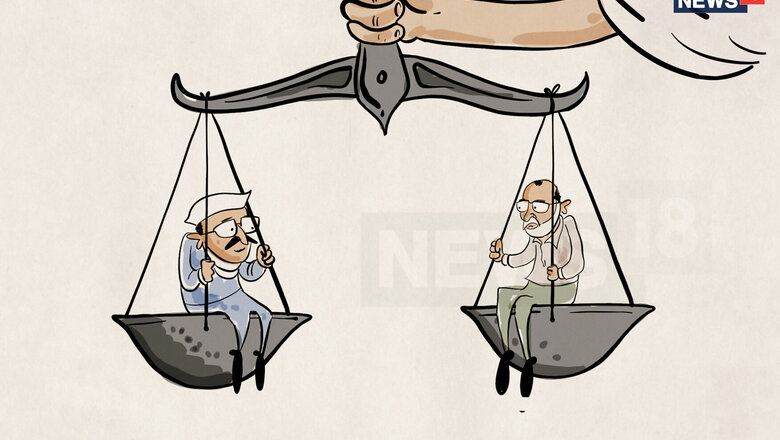
views
New Delhi: Who is the boss? Delhi chief ministers down the years have often pondered the question while facing disagreements with lieutenant governors, but never has the tension spiraled into a confrontation of the magnitude witnessed after the AAP came to power in 2015.
A series of ugly spats and subsequent showdowns involving the AAP-led government and the lieutenant governor's office finally landed at the Delhi High Court and later reached the Supreme Court which which handed a major victory to Chief Minister Arvind Kejriwal on Wednesday.
In a landmark judgment, the Supreme Court ruled that the LG has no independent power to take decisions and is bound by the elected government's advice.
At the core of the issue is the national capital's unique status of a Union Territory that is administered by both the Centre and the government of the National Capital Territory of Delhi.
Kejriwal's predecessors have had their share of disagreements with the Centre and the office of the LG, but this is at a different level, said old-timers.
Sheila Dikshit, who was the chief minister of Delhi for 15 years, said her government may have had differences with the LG, but there was never any "tussle".
"When differences came out, after talking to each other we sorted out those differences," the Congress leader, who was chief minister from 1998-2013, told PTI.
She expressed the hope that Delhi would finally witness some developmental work after the apex court verdict.
However, the Centre, many analysts feel, has traditionally had an upper hand in the administration as matters such as land and law and order are under the LG. The Supreme Court clarified today that except for three issues — public order, police and land — the Delhi government has the power to legislate and govern on other issues.
The genesis of the standoff between the AAP government and the Centre is the 2015 notification issued by the Union Home Ministry.
The May 2015 notification superseded the one issued in 1998, which had made it mandatory for the LG to consult the chief minister, not only on reserved subjects of police, public order and land but also for services.
In the gazette notification issued in 2015, the Home Ministry changed this, saying the LG will have jurisdiction over matters connected with services, public order, police and land and he may consult the chief minister whenever he thinks necessary in issues of services using his own "discretion".
The AAP, which had been at loggerheads with Lt Governor Anil Baijal over several issues, found itself in a difficult situation as it came to power on the promise of bringing about radical changes, but this was not possible after being hamstrung by the notification.
The AAP government then challenged the notification in the Delhi High Court, which held the validity of the Modi government's decision in 2016. The Kejriwal government appealed against the Delhi High Court judgment in the Supreme Court.
Dikshit said she and other chief ministers also had their share of differences with the LG's office during their tenure but the issues were settled through dialogue and political sagacity, indicating that Kejriwal has been adopting an attitude of confrontation.
The battle to establish 'who is the boss' has often turned ugly as seen with the alleged assault on Chief Secretary Anshu Prakash in February for which two AAP lawmakers were booked.
The current standoff is different because of AAP's "firebrand" approach, but tiffs between the chief minister and the Centre and the LG are not new to Delhi, said former Congress MLA Mukesh Sharma.
It all started with Delhi's first chief minister Chaudhury Brahm Prakash, who was hand-picked by then prime minister Jawaharlal Nehru in 1952, but the two later fell out. In 1955, Parkash was forced to resign and Gurumukh Nihal Singh was sworn in as chief minister.
On the basis of the recommendations of the state Reorganisation Commission, Delhi ceased to exist as a state in 1956. The legislative assembly was abolished in 1956, after which direct federal control was implemented until it was re-established in 1993.
After the Assembly was reinstated, the BJP emerged victorious with Madan Lal Khurana becoming chief minister.
Khurana had differences with then LG P K Dave over the Delhi government's decision to set up a committee to probe the 1984 anti-Sikh riots in the city.
The unease between the two came to the fore on other issues as well with Dave calling a press conference during which he accused the then BJP government of making an announcement related to sales tax without his consent.
After Khurana, BJP's Sahib Singh Verma and Sushma Swaraj also had brief stints as chief ministers of Delhi.
"Differences between CMs and LGs had cropped up so many times in two-and-half decades. But they were resolved amicably," said Sharma.
Dikshit came to power in 1998 following the Home Ministry notification. She, too, had her share of differences with LGs, including Vijai Kapoor, B L Joshi and Tejender Khanna.
She clashed with Kapoor, an NDA appointee, over several issues such as the delay in clearing the government's proposal to hike land acquisition compensation to farmers.
Dikshit, later had her way and got the LG's nod for compensation rates hike for farmers in August 2001.
She also had differences with Joshi and Khanna over several issues.


















Comments
0 comment